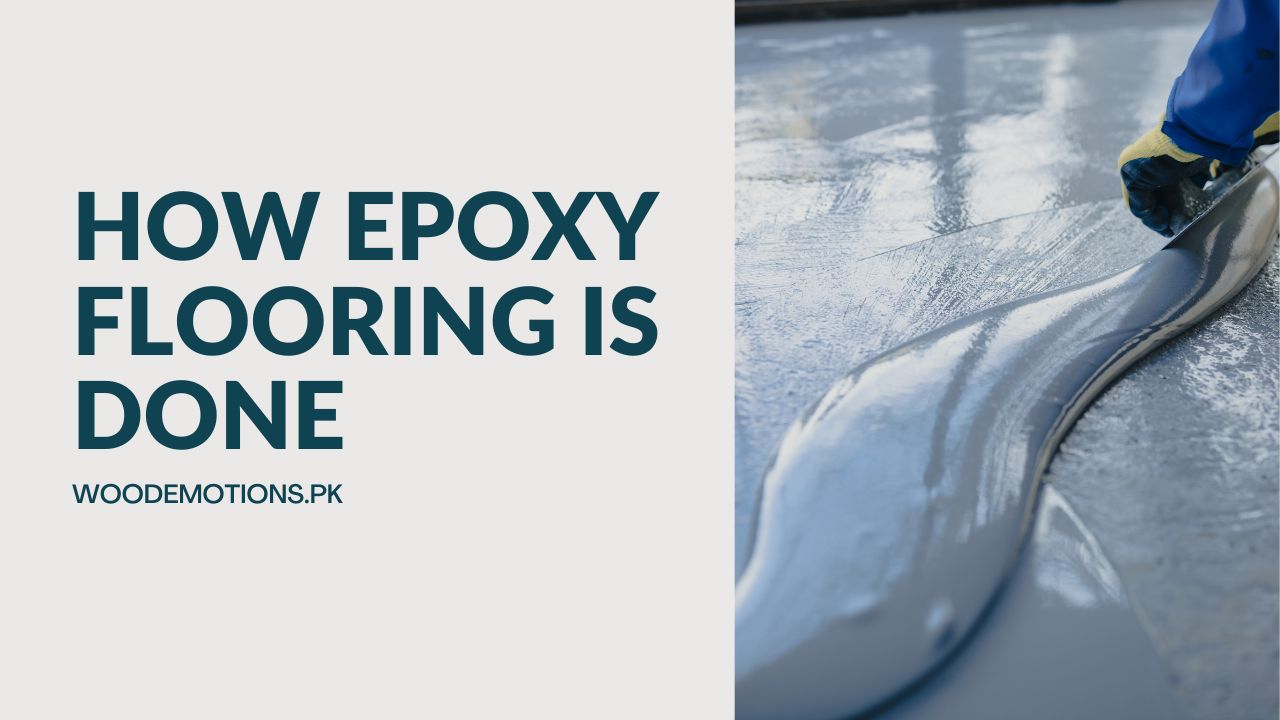Epoxy flooring is gaining popularity for its durability, versatility, and aesthetic appeal. Whether you're considering it for your home or commercial space, understanding the process of epoxy flooring is essential.
Epoxy flooring is applied by priming the surface, mixing epoxy resin and hardener, then spreading it evenly for a durable, seamless finish.
In this comprehensive guide, we'll walk you through everything you need about how epoxy flooring is done.
Types of Epoxy
When it comes to epoxy, there are different types to choose from. Each type has its characteristics and best uses. Let's break down the various types of epoxy to help you understand which one might be right for your project.
Water-Based Epoxy Flooring
Water-based epoxy flooring uses water as a carrier instead of solvent, making it environmentally friendly and odorless.
- Benefits: It is easy to clean, has low VOC emissions, and is suitable for residential applications due to its mild odor.
Solvent-Based Epoxy Flooring
Solvent-based epoxy flooring contains solvents as carriers, providing superior durability and resistance to chemicals and abrasions.
- Benefits: It is highly durable and resistant, making it suitable for industrial and commercial applications where toughness is crucial.
100% Solid Epoxy Flooring
100% solid epoxy flooring contains no solvents or water, resulting in a thick, high-build coating with exceptional durability and chemical resistance.
- Benefits: It provides a robust, long-lasting surface ideal for heavy-duty applications such as garage floors or manufacturing facilities.
Epoxy Mortar Flooring
Epoxy mortar flooring combines epoxy resin with fine aggregates like sand or quartz, creating a thick, trowel-applied, solid, and impact-resistant coating.
- Benefits: It is ideal for repairing and resurfacing damaged concrete floors in industrial settings where durability is paramount.
Self-Leveling Epoxy Flooring
Self-leveling epoxy flooring spreads evenly across a surface, creating a smooth, seamless finish.
- Benefits: It is ideal for leveling uneven or rough concrete floors and can be customized with decorative elements for a stylish finish.
Hybrid Epoxy Flooring
Hybrid epoxy flooring combines epoxy resins with other polymers or additives to enhance specific properties such as flexibility, UV resistance, or fast curing.
- Benefits: It offers versatility and can be tailored to various applications' requirements, from decorative coatings to industrial floorings.
Feel free to explore our epoxy collection page to browse through a wide range of flooring solutions, offering both durability and aesthetic appeal.
Unique Assets of Epoxy Resin

1. Durability
Epoxy resin creates a robust surface that can withstand heavy use and foot traffic without showing wear and tear.
2. Resistance to Chemicals
Unlike many other flooring options, epoxy is highly resistant to chemicals, making it suitable for environments where spills or chemical exposure is common.
3. Resistance to Mold and Bacteria
The seamless nature of epoxy flooring prevents moisture from seeping into the surface, reducing the risk of mold and bacterial growth.
4. Slip-Free Formula
Epoxy flooring can be formulated to provide excellent traction, reducing the risk of slips and falls even in wet or slippery conditions.
5. Easy Maintenance
Epoxy flooring is straightforward to clean and maintain, requiring only regular sweeping and occasional mopping to keep it looking new.
6. Versatile Design
The design possibilities are virtually endless with epoxy. It can be customized with various colors, patterns, and textures to suit aesthetic preferences.
Below are YouTube videos for a step-by-step method to visually assist you in learning. These videos will provide helpful guidance and enhance your understanding of the process.
Where is Epoxy Flooring Suitable?
Epoxy resin's versatility makes it suitable for various indoor and outdoor spaces in residential and commercial settings.
Ideal Applications Include:
1. Kitchens and Bathrooms
Epoxy flooring is perfect for these high-moisture areas due to its resistance to water and mold.
2. Garage Floors
The durability and chemical resistance of epoxy make it an ideal choice for garage floors, where spills and stains are common.
3. Outdoor Patios and Poolside Areas

Epoxy's ability to withstand UV exposure and harsh weather conditions makes it suitable for outdoor use.
4. Balconies and Terraces
Epoxy flooring can transform these outdoor spaces into stylish and durable extensions of your living area.
5. Office Buildings
Epoxy's sleek and professional appearance makes it a popular choice for commercial office spaces.
6. Hospitals, Hospices, and Pharmacies
The antibacterial properties of epoxy flooring make it ideal for healthcare environments where cleanliness is paramount.
7. Veterinary Clinics and Kennels
Epoxy's resistance to stains and odors makes it well-suited for animal care facilities.
8. Industrial Spaces
Epoxy flooring can withstand heavy machinery and constant foot traffic expected in industrial settings.
Benefits of Epoxy Flooring
- Epoxy's seamless surface makes it easy to wipe away spills and maintain a hygienic environment.
- Epoxy flooring can last many years without showing signs of wear, even in high-traffic areas.
- With epoxy, you can choose from various colors, patterns, and textures to create a unique look for your space.
- Despite its initial investment, epoxy flooring proves to be cost-effective in the long run due to its longevity and minimal maintenance requirements.
Preparation for Epoxy Flooring Installation
Before diving into the process of installing epoxy flooring, proper preparation is essential to ensure a successful and long-lasting result. Let's explore the crucial steps involved in preparing for epoxy flooring installation:
1. Surface Inspection and Cleaning
Before applying epoxy, thoroughly inspect the concrete surface for any cracks, chips, or imperfections. Repair any damages using suitable concrete repair products.
How should the surface be cleaned?
Clean the surface thoroughly to remove dirt, grease, oil, and other contaminants. Use a degreaser or concrete cleaner and scrub the surface with a stiff-bristled brush. Rinse the surface with clean water and allow it to dry completely.
2. Moisture Testing
Moisture can compromise epoxy adhesion to the concrete surface, leading to premature failure. Conduct moisture testing using a moisture meter or plastic sheet test to ensure the concrete is dry before proceeding with epoxy installation.
How do you perform moisture testing?
Place a plastic sheet or moisture meter on the concrete surface and seal the edges. Leave it in place for 24-48 hours, then check for condensation or moisture buildup. If moisture is present, take steps to mitigate it before applying epoxy.
3. Surface Profiling
Surface profiling involves creating a rough texture on the concrete surface to promote better epoxy adhesion. This is typically achieved using mechanical methods such as shot blasting or diamond grinding.
How do you perform surface profiling?
Using a shot blaster or diamond grinder to rub the concrete surface removes existing coatings, contaminants, and imperfections. Ensure that the surface is uniformly roughened to facilitate proper epoxy adhesion.
4. Masking and Protection
Masking helps protect adjacent surfaces, such as walls, baseboards, and fixtures, from accidental overspray or spills during epoxy application.
What materials are used for masking?
Use painter's tape and plastic sheeting to mask off areas not intended to be coated with epoxy. Ensure that all edges are properly sealed to prevent seepage of epoxy onto unprotected surfaces.
Application and Maintenance of Epoxy Flooring

Applying epoxy flooring involves several vital steps to ensure a successful and long-lasting finish:
- Priming: Seal the concrete surface to create a strong bond with the epoxy coating.
- Mixing: Properly mix the resin and hardener components in the correct ratio for optimal performance.
- Applying the Epoxy: Use a roller or squeegee to apply the epoxy evenly, working quickly to avoid drips or puddles.
- Curing Process: Allow the epoxy to cure and harden, with drying time influenced by temperature and humidity.
- Final Inspection: Conduct a thorough inspection to ensure a smooth, even surface free of imperfections.
Also Read : How Long Does Epoxy Resin Take To Dry
Maintenance of epoxy flooring
- Regular Cleaning: Sweep, vacuum, and mop with a mild detergent to remove dirt and debris.
- Preventive Measures: Avoid dragging heavy objects and use mats or rugs in high-traffic areas to prevent scratches and damage.
Considerations for epoxy flooring also include
- Cost: Factors such as size, type, and customization options affect the overall cost, with epoxy often proving cost-effective due to its durability.
- DIY vs. Hiring: While DIY installation is possible, professional installers offer expertise and efficiency for a flawless finish.
- Popular Brands: Choose reputable brands like Rust-Oleum and Sherwin-Williams for quality and performance assurance.
- Environmental Impact: Eco-friendly options like water-based and low-VOC epoxy minimize environmental harm.
FAQs
1. How long does epoxy flooring last?
Epoxy flooring can last for several years with proper maintenance and care. On average, it can withstand heavy use for 5-10 years before needing to be recoated.
2. Can epoxy flooring be installed over existing flooring?
In most cases, epoxy flooring can be installed over existing concrete surfaces. However, it's essential to ensure the existing flooring is in good condition and properly prepared before applying epoxy.
3. Is epoxy flooring slippery?
While epoxy flooring is smooth and glossy, it can be made slip-resistant by adding aggregates such as quartz or silica sand to the epoxy mixture.
Conclusion
Epoxy flooring is achieved through priming, mixing, and application, providing a durable and seamless finish. Its versatility and durability make it a popular choice for residential or commercial use. Proper installation ensures longevity and enhances both aesthetics and functionality.







